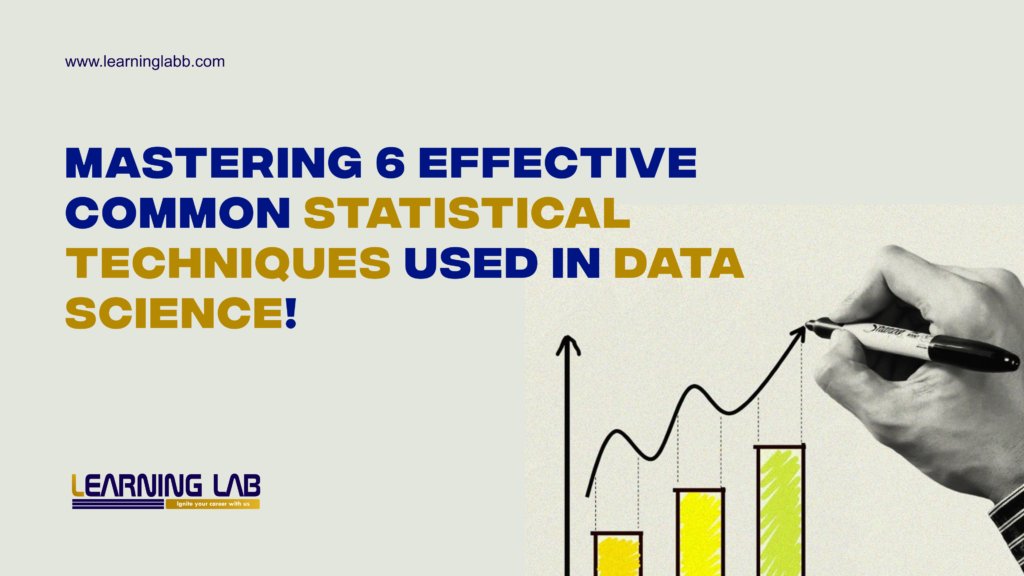Data science has revolutionized the way organizations make decisions and derive insights from vast amounts of data.
To harness the power of data, statisticians and data scientists rely on a variety of statistical techniques data scientists need to master.
In this comprehensive guide, we will delve into what are some common statistical techniques used in data science that form the backbone of data science.
From regression analysis to hypothesis testing, clustering, and more,if you know what are some common statistical techniques used in data science then these techniques play a pivotal role in extracting meaningful patterns and insights from complex datasets.
What are some common statistical techniques used in data science?
Statistical techniques in data science refer to a set of methods and tools used to analyze, interpret, and draw meaningful insights from data.
These techniques play a crucial role in understanding patterns, relationships, and trends within datasets, enabling data scientists to make informed decisions and predictions.
In the world of data science, the statistical techniques data scientists need to master encompass a wide range of approaches that help uncover hidden information and structure in data.
These techniques involve mathematical and computational methods that aid in summarizing data, testing hypotheses, making predictions, and exploring relationships between variables.
Some common statistical techniques used in data science include:
1. Regression Analysis:
Regression analysis is a fundamental technique used to understand the relationship between variables.
It helps data scientists predict outcomes based on one or more independent variables.
So if you are the one interested in knowing what are the statistical methods for data science then Linear regression, for instance, estimates the linear relationship between variables, while logistic regression is certainly applied when the dependent variable is binary.
2. Hypothesis Testing:
Hypothesis testing is essential for making inferences about a population based on sample data.
It involves formulating a null hypothesis and an alternative hypothesis and using statistical tests to determine whether there’s enough evidence to reject the null hypothesis.
Techniques like t-tests and ANOVA are commonly used for hypothesis testing.
3. Clustering:
Clustering entails an unsupervised learning approach, wherein data points with resemblances are grouped together.
K-means clustering, hierarchical clustering, and DBSCAN are popular algorithms for grouping data points based on their similarities.
Clustering helps identify patterns and segments within datasets, aiding in better understanding customer behavior or market trends.
This is one of the statistical techniques data scientists need to master.
4. Decision Trees:
If you are in search of which of the following analytical and statistical techniques do data scientists commonly use then Decision trees are a versatile tool for classification and regression tasks.
They include creating a tree-like model of decisions and their possible consequences so that we can get accurate decisions.
Decision trees are easy to interpret and can handle both categorical and numerical data, making them valuable for data-driven decision-making.
5. Time Series Analysis:
Time series analysis deals with data points collected at regular intervals over time.
This technique is vital for forecasting future trends and patterns, making it essential for financial predictions, weather forecasting, and more.
ARIMA (AutoRegressive Integrated Moving Average) and exponential smoothing methods are commonly employed in time series analysis.
6. Principal Component Analysis (PCA):
PCA serves as a technique for reducing dimensionality, converting complex high-dimensional data into a more compact, lower-dimensional form.
It identifies the most significant features in the data and projects them onto a new coordinate system.
PCA is used to simplify complex datasets, improve visualization, and remove noise Making it one of the effective statistical techniques data scientists need to master.
FAQs:
What Are Some Real-world Applications of Regression Analysis?
Regression analysis finds applications in various fields, from economics to healthcare. In economics, it’s used to predict consumer demand based on historical data. In healthcare, it helps in predicting patient outcomes based on factors like age, gender, and medical history.
How Does Clustering Benefit Market Segmentation?
Clustering aids in market segmentation by identifying groups of customers with similar preferences or behavior. This information helps businesses tailor their marketing strategies to target specific segments effectively.
Can Decision Trees Handle Missing Data?
Yes, decision trees can handle missing data by placing the missing data in the branch with the highest probability. However, imputing missing data before building the tree often leads to better results.
What Is the Key Advantage of Time Series Analysis?
The key advantage of time series analysis is its ability to capture and predict trends that evolve over time. This is crucial for making informed decisions in industries where future predictions are essential, such as finance and supply chain management.
How Does PCA Improve Data Visualization?
PCA reduces the dimensions of data while retaining as much information as possible. This makes it easier to visualize complex datasets in lower-dimensional space, aiding in identifying patterns and relationships.
Is Hypothesis Testing Limited to Two Groups?
No, hypothesis testing can involve more than two groups. ANOVA (Analysis of Variance) is a statistical test used when there are more than two groups to compare means.
Conclusion:
In the dynamic landscape of data science, if you are searching for what are some common statistical techniques used in data science then these six common statistical techniques are invaluable tools for extracting insights, making predictions, and guiding decision-making.
Whether you’re a seasoned data scientist or a novice exploring the world of data analytics, understanding these techniques will empower you to unlock the hidden potential within complex datasets.





